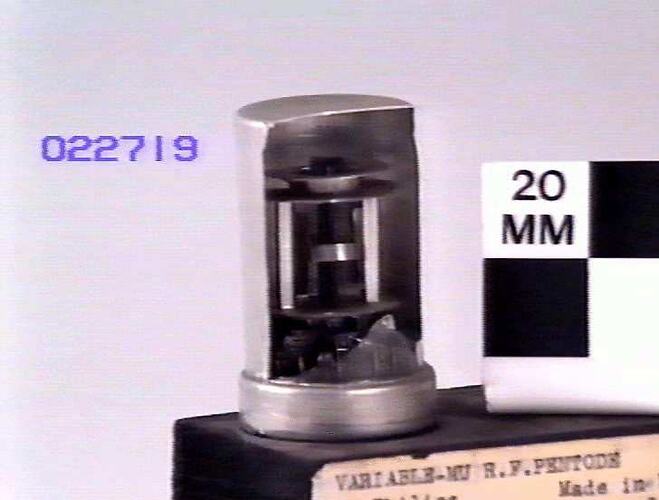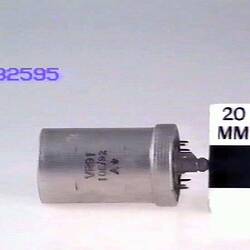Summary
6.3 V indirectly heated cathode, manufactured by Mullard, England, 1940-1945. Manufactured for the Royal Air Force (R.A.F.), England. It is a pentode with a relatively high transconductance, designed for use in wide-band amplifiers.
VR91 is the Royal Air Force designation for the EF50 valve. It was developed in the late 1930s for Pye by Philips in Holland for use in television receivers. It was found to be very suitable for use in radar equipment and was produced in very large quantities during World War II (1939-1945) for that purpose.
When it became apparent that Holland would be overrun by the Nazis, the manufacturing equipment used to make the EF50 valve was airlifted from the Philips factory in Eindhoven to a Mullard factory in England to ensure continued availability of this essential valve. Later in the war these valves were also made by Sylvania in the USA to meet the demand for them. The inscription on the display block states that the manufacturer was Philips, but, in view of the military designation applied to this valve, this is unlikely.
The exposed structure reveals the typical wide band pentode structure with its anode made as small as possible and spaced well away from the rest of the structure to minimise the output capacitance of the valve to obtain the maximum gain-bandwidth product.
Physical Description
Internal structure of a wide-band pentode with its outer aluminium casing sectioned and its internal glass bulb removed. Mounted on a display block.
More Information
-
Collection Names
-
Collecting Areas
-
Acquisition Information
Purchase
-
Manufacturer
-
Inscriptions
On the outer casing: VR91/10E-92/A(broad arrow pointing down) On display block: Identification of valve and brief description of characteristics. The inscription states that the manufacturer was Philips but in view of the military designation applied to this valve, this is unlikely; see object summary.
-
Brand Names
-
Classification
-
Category
-
Discipline
-
Type of item
-
Overall Dimensions
105 mm (Height), 44 mm (Outside Diameter)
Not including display block.
-
Keywords

